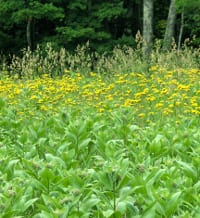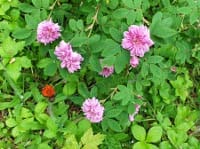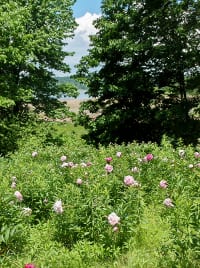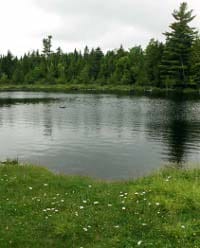Linking natural systems with human ecology to develop sustainable and meaningful landscapes.
by Ann Kearsley
Evidence of the history of human habitation in New England surrounds us, knit seamlessly into the texture of our daily lives. This landscape has been shaped by generations of people living on the land, their cultures and actions precipitating and responding to changes in the region’s ecology, hydrology and plant communities.
The topography and plant materials of rural areas and suburbia are evidence of our relationship to the land; how we worked on it, how we moved over it, how we fed ourselves and our animals, how and where we extracted resources and built shelters. The ridgelines and swales of farm fields are shaped by the dimensions of the equipment used to plow, plant and harvest. Local roadways follow the lines of paths worn leading cows to pasture, curves and inclines softened over time to accommodate horse and cart, and later, cars and trucks. Timothy and Orchard Grass, found today in virtually every old field, were 18th century introductions planted as forage for animals and harvested for hay. Urban forms in older cities also reflect the history of occupation, though more recent, large-scale developments tend to erase the evidence of earlier inhabitants, leveling sites with efficient earth moving equipment and acres of paving and structure.
Landscape as Historic Record
A landscape’s plants hold the record of our aesthetic relationship to nature and our desire to attract wildlife to our gardens; gnarly old lilacs blooming in colors long gone from the marketplace, panicled hydrangeas marooned as specimens in the front yard, an ancient peony’s enormous blooms appearing with Hawkweed and Queen Anne’s Lace along the remains of a foundation wall. Someone chose these plants, placed and planted them, pruned, watered and fertilized them, cherishing their annual fleeting gift of color and scent. Birds nest in their twiggy branches, bees visit their flowers, ants drink their nectar and small animals eat their seeds.

Native Milkweed with New England Hawkweed (19c introduction) and Orchard Grass (18c introduction) in an old field, Belfast, Maine. ©annkearsleydesign 2010
Since the mid 20th century, we have shifted away from knowing the natural world through the physical labor of working on the land. Nature has become something we need to dress for and drive to. Nature is a place we visit; it provides habitat for non-human animals and respite and recreation for us. But we don’t live in Nature and we don’t consider the built environment we do inhabit to be natural. As we have turned away from our physical, working relationship with the land, we no longer see a positive reflection of our culture or our labor in its forms and materials. We see the evidence of our presence in the natural world as negative and destructive and imagine that creating a place for our selves inevitably leads to the displacement and diminution of other creatures.
A Niche for Introduced Species
This negative judgment is expressed in the current state of ecologically based landscape design. Many advocates for sustainable design call for the exclusive use of native plants, a practice intended to support indigenous ecosystems, provide habitat resources for wildlife and promote the use of plants adapted to the local environment.
All of these are important, pressing goals, and certainly intact native landscapes should be protected and preserved. But the majority of designed landscapes in New England are being built in the ‘middle landscape’ of suburbia and exurbia, on land that has been inhabited for generations and contains a mix of native and naturalized introduced species. Most of these non-native species have been growing in our landscapes for hundreds of years and have become an essential part of our New England ecosystems. They provide habitat resources for wildlife, are adapted to the cultural conditions of our region, and often colonize habitat niches in the built environment that are unsuitable for native plants (see Peter Del Tredici, Wild Urban Plants of the Northeast, Cornell University Press, 2010)
The prescriptive insistence that a sustainable landscape design be limited to a native plant palette frames an overly simplistic and reductionist view of the current state of our natural world. It excises our history and negates a fundamental aspect of how humans have lived and worked within nature for millennia. Sustainable design should encourage investigations of the dynamics of the existing ecology of a project landscape, with the productive elements of that system forming the basis of a new design.

Old Rose, Orange Hawkweed and native Bunchberry at the edge of a clearing, North Woods, ME ©annkearsleydesign 2009
Both native and introduced species should be considered for their potential contributions (or negative impacts) on a site’s ecosystem, as well as for the sheer pleasure we take in their colors, fragrances and forms. We should acknowledge the essential role humans have played in a site’s environmental history, remediating our mistakes, but also celebrating the record of our love for and connection with our landscapes. Nature is just outside the front door; we need to be at home in it.
About the Author
 Ann Kearsley RLA, MLAUD, is a registered landscape architect and urban designer with over twenty-seven years experience designing and building ecologically and culturally sustainable landscapes for institutions, communities, and individuals. She is the owner and principal of Ann Kearsley Design, a landscape architecture and urban design firm based in Portland, ME and teaches courses on Sustainable Site Engineering, Contemporary Ecology, and Green Roofs and Rain Gardens at the Landscape Institute in Boston, MA. Ann may be reached at www.annkearsley.com.
Ann Kearsley RLA, MLAUD, is a registered landscape architect and urban designer with over twenty-seven years experience designing and building ecologically and culturally sustainable landscapes for institutions, communities, and individuals. She is the owner and principal of Ann Kearsley Design, a landscape architecture and urban design firm based in Portland, ME and teaches courses on Sustainable Site Engineering, Contemporary Ecology, and Green Roofs and Rain Gardens at the Landscape Institute in Boston, MA. Ann may be reached at www.annkearsley.com.



